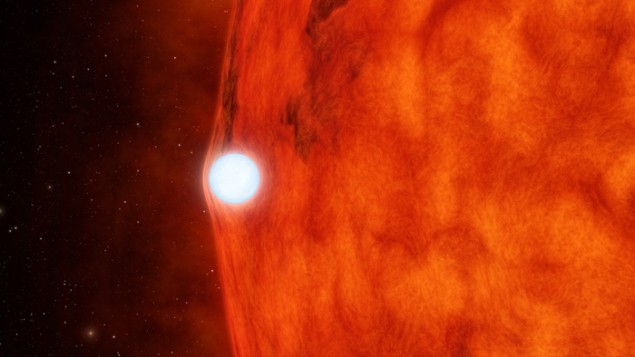
For the first time, astronomers have seen a double star brighten rather than fade when one star passes in front of its companion. Predicted decades ago, the phenomenon arises from gravitational microlensing as the great surface gravity of a white-dwarf star magnifies its partner’s light. The discovery by US researchers raises the hope that we will someday catch a neutron star or black hole doing the same thing, which would lend new insight into these extreme objects.
Many star systems are double, having two stars that orbit each other. In some cases, the orbit aligns edge-on to our line of sight, so that one star periodically eclipses the other and dims the light that we see. Astronomers have known of these eclipsing binaries for centuries. The best example is Algol – Arabic for “the ghoul” – which medieval astrologers considered to be the most dangerous star in the sky, probably because they knew that its light flickers. In 1782 British astronomer Edward Pigott correctly explained why Algol dims.
It was not until 1973 that Swiss astronomer André Maeder predicted that some binaries should exhibit the opposite phenomenon. According to both Newton’s theory of gravity and Einstein’s general theory of relativity, mass bends light. Therefore, Maeder says, if a small but massive star eclipses its companion, then the small star’s gravity should amplify the other star’s light so much that it overwhelms the eclipse-induced darkening.
Discovery at last
Now, four decades later, a pair of astronomers has discovered the first example, 2600 light-years away. “We found it by accident,” says Ethan Kruse, a second-year graduate student at the University of Washington in Seattle. “My main research is looking for new planets that other people have missed.”
In early December 2013 Kruse was examining KOI 3278, a star that NASA’s Kepler spacecraft had found to be fading every 88.18 days. This suggested that a planet circled the star with that periodicity and dimmed the light as it passed in front.
But Kruse noticed a strange feature. “The first thing I thought was that something had gone horribly wrong,” he says. “Instead of finding a new planet, I found what looked to be the same signal as a planet transiting its star except upside down, where the star got brighter instead of dimmer.” Each brightening was subtle, just 0.1%, and lasted five hours. The brightenings repeated every 88.18 days, out of phase with the dimmings.
In fact, KOI 3278 has no known planet. Instead, it consists of a star like the Sun coupled with a white dwarf, a small dense star. The system dims when the white dwarf passes behind the Sun-like star and brightens when the white dwarf passes in front, magnifying the light of its mate.
More exotic objects
“This is a very nice surprise,” says Maeder, who is now 72 years old. “I must say, I more or less forgot about this effect, and as a matter of fact, I did not expect it would be found in my lifetime.”
Edge-on binaries containing more exotic objects – neutron stars and black holes – should also display periodic brightenings. “That’s what I think is most interesting,” Kruse says. “There are not a lot of people looking for such signals, and they might find them in the Kepler data.” Such systems would yield new information on the masses of neutron stars and black holes.
“It’s supercool!” says B Scott Gaudi, an astronomer at Ohio State University in Columbus. “It just shows the power of Kepler. You open up parameter space and you’re guaranteed to find really interesting stuff.” Last year, other astronomers reported a Kepler system with a white dwarf, but the gravitational brightening was too small to erase the eclipse.
Kruse and his university colleague Eric Agol have published their discovery online today in Science.



